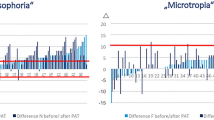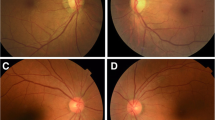Abstract
Esotropic patients whose angle of strabismus has been corrected by prisms frequently increase their angle deviation to compensate for the prismatic correction. This sensorio-motorial reaction to prism correction has been given the name of anomalous movements (a.m.). Quantification of a.m. has been made according to the amount of prisms that an esotropic patient is capable of compensating for (progressive prism compensation test - p.p. test). Some esodeviation does not compensate for any prisms at all since a.m. have not yet developed. Other cases compensate for as much as 40 or 60 prism diopters and more of over-correction of the angle deviation and they therefore have powerful a.m. The interference of these innervational forces acting on the medial recti to corrective surgery has been studied in 126 operated esotropic patients. A significant decrease from the expected surgical result (p < 0.001) has been found in patients having powerful a.m., as can be judged by the p.p. test. It is believed that a.m. are an important drawback contributing to vitiate any formula on the amount of muscle surgery to be performed in patients having no possibilities of restoring normal binocular vision.
Practical advice on how to eliminate this drawback and theoretical reasoning on the significance of a.m. are offered.
Similar content being viewed by others
References
Adelstein FE and Cüppers C (1970) Le traitement de la correspondence rétinienne anormale à l'aide des prismes. Ann Oculist (Paris) 203: 445
Aust V and Welge-Lussen L (1971) Pre-operative and post-operative changes in the angle of squint following long-term pre-operative prismatic compensation. In: The First Congress of the International Strabismological Association, Ed Fells P. London, Kimpton, p 217
Bagolini B (1962) Consideration generales sur le C.V. binoculaire du strabisme. ERG et Champ Visuel - Symp Jubil Jacques Daviel - Marseille, 1962
Bagolini B and Capobianco NM (1965) Subjective space in comitant squint: Amer J Ophthal 59: 430
Bagolini B (1966) Postsurgical treatment of convergent strabismus, with a critical evaluation of various tests. Int Ophthal Clin 63: 633
Bagolini B (1967) Anomalous correspondence: definition and diagnostic methods. Docum Opthal 23: 346
Bagolini B (1967) Discussion of Hugonnier's paper in: Symposium sur l'amblyopie strabique, Liège, 1965. Docum Ophthal 23, 445
Bagolini B (1971) Anomalies sensoriales del estrabismo. Actas: III Congreso del Consejo Latino-Americano de Estrabismo (CLADE), Mar del Plata, 1971, p 359
Bagolini B (1976) Part I: Sensorial anomalies in Strabismus (Suppression, anomalous correspondence, amblyopia). Docum Ophthal 41: 1
Bagolini B (1976) Part II: Sensorio-motorial anomalies in strabismus (Anomalous movements). Docum Ophthal 41: 23
Bagolini B (1982) Anomalous fusion. Docum Ophthal Proc Ser 32: 41
Bagolini B (1985) Objective evaluation of sensorial and sensoriomotorial status in esotropia: their importance in surgical prognosis. Brit J Ophthal 69: 725
Burian H (1950) The principle of surgery in extraocular muscles. Part I: Fundamental principles: choice of operation in comitant strabismus. Horizontal muscles. Amer J Ophthal 33: 380
Campos E and Zanasi MR (1978) Die anomalen Fusionsbewegungen: der Sensò motorische Aspekt des anomalen Binokularsehens. Graefes Arch Klin exp Ophthal 205: 101
Catros A and Garrec A (1974) Les prismes dans le traitement préōpératoire du strabisme de l'adult. Acta of the II Meeting of International Strabism. Assoc. Marseille, 1974, p 268
Ciancia AO (1965) La corrispondencia sensorial en los sindromes an A. y V. J Ped Ophthal 2: 15
Collins CC, Carlson MR, Scott AB and Jampolsky A (1981) Extraocular muscle forces in normal human subjects. Invest Ophthal 20: 652
Deller M (1980) La mia chirurgia delle esotropie ad angolo variabile. Giorn Ital Ortott 7: 61
Halldén U (1952) Fusional phenomena in anomalous correspondence. Acta Ophthal 37 (suppl.): 1
Helveston EM, Noorden GK von and Williams F (1970) Retinal correspondence in the A or V patterns. Amer Orthopt J 20: 22
Jampolsky A (1971) A simplified approach to strabismus diagnosis. In: Symposium on Strabismus, Trans. New Orleans Acad Ophthal. St. Louis, Mosby p 34
Johnston A (1971) Clinical horopter determination and the mechanism of binocular vision in anomalous correspondence. Ophthalmologica 163: 102
Nelson JI (1981) A neurophysiological model for anomalous retinal correspondence based on mechanism of sensory fusion. Doc Ophthal 51: 3
Noorden GK von and Jampolsky A (1978) Round table discussion. In: Symposium on Strabismus, Trans. New Orleans Acad Ophthal. St. Louis, Mosby p 567–8
Ogle KN and Prannen A (1953) Observations of vertical divergences and hyperphorisas. Arch Ophthal 49: 313
Pasino L and Maraini G (1966) Areas of binocular vision in anomalous correspondence. Brit J Ophthal 50: 646
Prieto Diaz J (1970) Les relationes binoculaires en las microtropias. Arch. Ophthal. (B. Aires) 45: 275
Quéré MA (1983) Physiopathologie clinique de l'équilibre oculomoteur. Paris, Masson
Quéré MA (1984) Chirurgie de Strabismes, ed Bernard PV, Quéré MA, Roth A, Spielmann A, Woillez M Paris, Masson
Robinson DA, O'Meara DM, Scott AB and Collins CC (1969) Mechanical components of human eye movements. J Appl Physiol 26: 562
Robinson DA (1975) A quantative analysis of extraocular muscle coordination and squint. Invest Ophthal 14: 801
Schor CM (1983) Fixation disparity and vergence adaptation. In: Vergence Eye Movements, eds Schor CM and Ciuffreda KJ. Boston, Butterworths, p 465
Scott AB, Collins CC and O'Meara D (1972) A forceps to measure strabismus forces. Arch Ophthal 88: 330
Scott WE (1978) Office use of prisms. In: Symposium on Strabismus, Trans. New Orleans Acad Ophthal. St. Louis, Mosby, p 91
Stone J, Dreher B and Levelthal A (1979) Hierarchical and parallel mechanisms in the organisation of visual cortex. Brain Res Rev 1: 345
Author information
Authors and Affiliations
Rights and permissions
About this article
Cite this article
Bagolini, B., Zanasi, M.R. & Bolzani, R. Surgical correction of convergent strabismus: its relationship to prism compensation. Doc Ophthalmol 62, 309–324 (1986). https://doi.org/10.1007/BF00168263
Issue Date:
DOI: https://doi.org/10.1007/BF00168263




